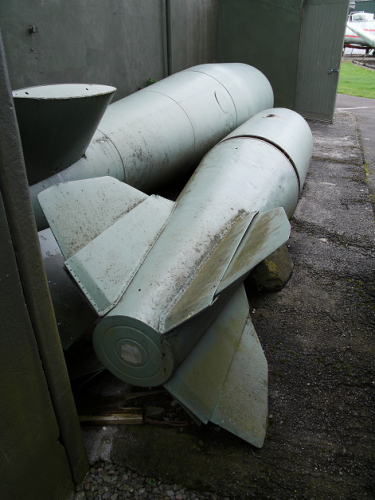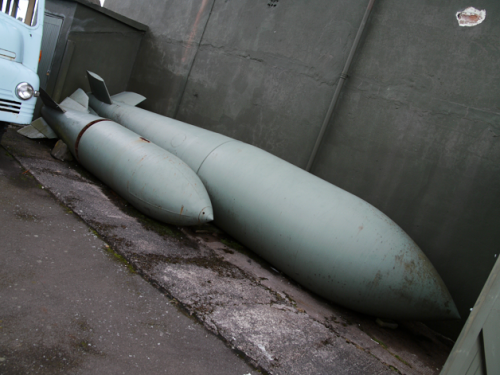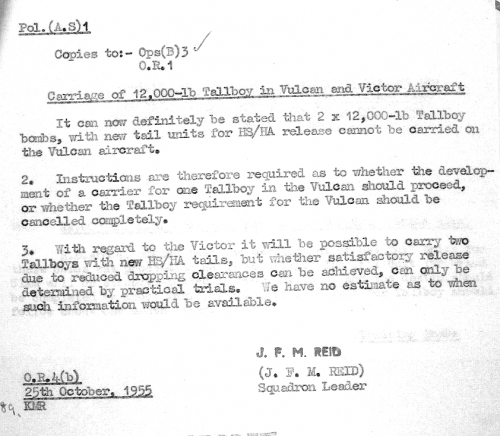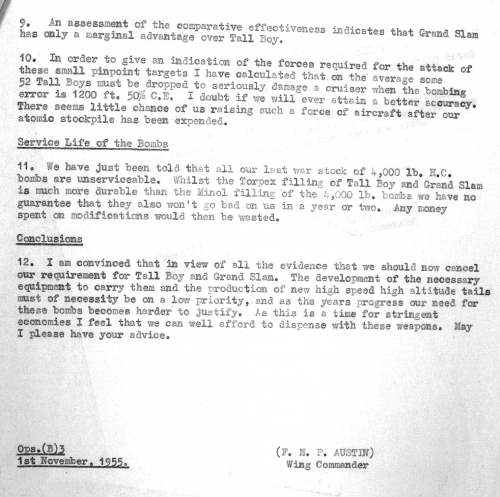Such bombs are mentioned in some books or articles about V-bombers and Canberra. E.g. in Aerofax "Vickers Valiant" as a alternative loads (beside of nukes) are 1 x 10000 lb HC or 2 x 5000 lb HC bombs. Maybe someone have some information about these bombs? Are they really existed, or only in project stage?
You are using an out of date browser. It may not display this or other websites correctly.
You should upgrade or use an alternative browser.
You should upgrade or use an alternative browser.
British post-war 5000 lb HC and 10000 lb HC bombs - any info?
- Thread starter Speedy
- Start date
- Joined
- 6 September 2006
- Messages
- 4,839
- Reaction score
- 9,481
I think such bombs were studied, probably as a back-up to nuclear weapons. Generally the 5,000lb and 10,000lb HC bombs seem to have formed the basis of the larger Blue Boar TV-guidance and Red Cheeks inertial-guidance guided-bomb research projects. The larger versions never even reached the aerodynamic trials stage, so the bombs themselves probably didn't exist at the time.
I doubt the Air Staff seriously considered such bombs to be useful without guidance to hit their intended targets.
I doubt the Air Staff seriously considered such bombs to be useful without guidance to hit their intended targets.
- Joined
- 1 January 2009
- Messages
- 138
- Reaction score
- 176
A 5,000lb HA/HS bomb (a larger version of the Mk.6 1,000lb bomb) was developed for the Canberra (and dropped in trials) but was cancelled on cost grounds circa 52. The 10,000lb bomb (for V-bombers) had finished development by 1955 but was canned (on cost grounds, and doubts regarding its employment) in mid-year.
(Edited after consulting files)
(Edited after consulting files)
there are a few large unidentified casings at Dumfries aircraft museum, one in particular looks to be a slightly smaller 'Tallboy', il see if I can manage to upload some pics
- Joined
- 26 May 2011
- Messages
- 2,322
- Reaction score
- 3,478
pics from Solway Air Museum at Dumfries.
I have photos of the manufacturer's plates (Scottish Aviation) but they are a bit worn and don't tell (well, don't tell me) much.
I seem to recall there was a pair of reasons the Tallboy wasn't intended for the V-bombers. The first was they needed new tail units for carriage in Vulcan and Victor and the second was that the explosive (Torpex) might deteriorate if stored for more than two years.
Chris
I have photos of the manufacturer's plates (Scottish Aviation) but they are a bit worn and don't tell (well, don't tell me) much.
I seem to recall there was a pair of reasons the Tallboy wasn't intended for the V-bombers. The first was they needed new tail units for carriage in Vulcan and Victor and the second was that the explosive (Torpex) might deteriorate if stored for more than two years.
Chris
Attachments
According to deterioration of explosives, there was some accidents with Tarzon (American Tallboy-based guided bomb) in the Korean War. The bombs exploded even if were safe dropped from low altitude. Deterioration could be a reason. On other hand, US Tallboy had some version and I don't know which one was converted to Tarzon. Early models were build exactly as British, with cast warhead and filled with torpex in TNT mantle, then they switch to cheaper technique with warhead made from rolled plates in process similar to manufacturing high-pressure vessels, steam boilers etc., and tritonal explosive. Breaking the shell when hit the ground could also caused explosion.
- Joined
- 26 May 2011
- Messages
- 2,322
- Reaction score
- 3,478
JFC - I read it as there being no aircraft left to carry them, since there appears to be some scepticism about the V-force returning to base. Weren't the crews issued with instructions to head elsewhere rather than back to Blighty?
Chris
Chris
- Joined
- 5 May 2007
- Messages
- 1,483
- Reaction score
- 2,860
I'm not sure that the two sides aren't incompatible. For the Air Ministry to write about the requirement no longer being valid strongly implies that it was a requirement at some previous point.
- Joined
- 26 May 2011
- Messages
- 2,322
- Reaction score
- 3,478
The file says that it could take 56 Tallboys to sink a cruiser, (based on Tirpitz experience I think) so not worth the effort. Also by 1955 Green Cheese was on the cards for use by Valiants against ships.
Chris
Chris
[quote author=JF] broken-backed warfare was UK strategic thinking up to 1955/56, it assumed a period of conventional war after initial nuclear war.
[/quote]
I agree that such scenario is very improbable. After exchanging nuclear strikes probably no one would be able to continue the war. But how about limited wars, without using the nukes? After ww2 British forces fight in some such conflicts, in Greece, Malayan Emergency, Korean war and Suez Crisis (the last was in 1956 so a year after attached documents). I think the heavy conventional bombs could be quite useful in such wars.
[/quote]
I agree that such scenario is very improbable. After exchanging nuclear strikes probably no one would be able to continue the war. But how about limited wars, without using the nukes? After ww2 British forces fight in some such conflicts, in Greece, Malayan Emergency, Korean war and Suez Crisis (the last was in 1956 so a year after attached documents). I think the heavy conventional bombs could be quite useful in such wars.
- Joined
- 26 May 2011
- Messages
- 2,322
- Reaction score
- 3,478
This is interesting

 www.bbc.co.uk
www.bbc.co.uk
Chris

WW2 'earthquake' bomb explodes in Poland during attempt to defuse it
The blast of the WW2 bomb in a canal in Poland was not unexpected and divers were unharmed.
Chris
- Joined
- 6 September 2006
- Messages
- 4,839
- Reaction score
- 9,481
This is interesting

WW2 'earthquake' bomb explodes in Poland during attempt to defuse it
The blast of the WW2 bomb in a canal in Poland was not unexpected and divers were unharmed.www.bbc.co.uk
When I saw last night that they had found a Tallboy I thought it would be tricky to deal with without a big bang. I guess nobody has tried to deal with one for 70 years and the filling most have been pretty unstable.
Which airforces still have the capability to drop a weapon in the Tallboy and Grandslam class. I would image the US, Russian and Chinese AFs', as they are the only AFs' with "bombers" rather than strike aircraft?
What would the RAF use to undertake the targets the earthquake bombs undertook.
What would the RAF use to undertake the targets the earthquake bombs undertook.
According to deterioration of explosives, there was some accidents with Tarzon (American Tallboy-based guided bomb) in the Korean War. The bombs exploded even if were safe dropped from low altitude. Deterioration could be a reason. On other hand, US Tallboy had some version and I don't know which one was converted to Tarzon. Early models were build exactly as British, with cast warhead and filled with torpex in TNT mantle, then they switch to cheaper technique with warhead made from rolled plates in process similar to manufacturing high-pressure vessels, steam boilers etc., and tritonal explosive. Breaking the shell when hit the ground could also caused explosion.
The differences in construction between the British and US bombs is noted here.
Bomb, 12000 lb GP, T10
Description British Tail Pistol No. 58 Mk 1 is used at present, but these will eventually be replaced with the Air Arming Fuzes T723, placed 120º apart in the base plate. The fu
But I have a recollection that Tallboys/Grand Slam built in wartime in the US were constructed in 3 parts. Note the use of the future tense regarding the T10 and its 5 parts.
All the Tallboys and Grand Slams constructed in the US for the RAF were filled in Britain.
lastdingo
Blogger http://defense-and-freedom.blogspot.de/
Such large bombs can be dropped by large cargoa ircraft from a ramp. It's actually easier than adapting a heavy bomber for it.Which airforces still have the capability to drop a weapon in the Tallboy and Grandslam class. I would image the US, Russian and Chinese AFs', as they are the only AFs' with "bombers" rather than strike aircraft?
What would the RAF use to undertake the targets the earthquake bombs undertook.
I knew that MOABs were dropped from C130's didn't realise that Equake bombs could be dropped from them as well.Which airforces still have the capability to drop a weapon in the Tallboy and Grandslam class. I would image the US, Russian and Chinese AFs', as they are the only AFs' with "bombers" rather than strike aircraft?
What would the RAF use to undertake the targets the earthquake bombs undertook.
This is interesting

WW2 'earthquake' bomb explodes in Poland during attempt to defuse it
The blast of the WW2 bomb in a canal in Poland was not unexpected and divers were unharmed.www.bbc.co.uk
Chris
Wonder if they used this method?
the SAL. made casing at Dumfries & Galloway Aircraft Museum looks to be a British 22,000Lb Block Buster ? ref. https://bombfuze.net/gallery.html
I was starting to wonder if it may have been connected with Violet Club due to the 'flip out' fins ? ref. https://www.google.com/search?q=blu...rlz=1C1CHBF_enGB853GB853#imgrc=HnRe73DFpKSV-M

I was starting to wonder if it may have been connected with Violet Club due to the 'flip out' fins ? ref. https://www.google.com/search?q=blu...rlz=1C1CHBF_enGB853GB853#imgrc=HnRe73DFpKSV-M
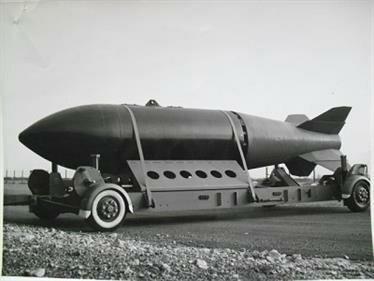
Not really. Violet Club casings were simply modified Blue Danube casings with the flip-out tails manufactured at the former Blackburn Aircraft works in Leeds. Similarly, all the Christmas Island H-bomb test detonations all used modified Blue Danube casings for essentially two reasons. Firstly to avoid mounting additional and expensive ballistic drop trials for a new Violet Club weapon that was no more than a temporary stopgap weapon until Yellow Sun casings became available for Yellow Sun Mk1. Only 37 were built so drop trials for such a low production run would be unseemly expensive.the SAL. made casing at Dumfries & Galloway Aircraft Museum looks to be a British 22,000Lb Block Buster ? ref. https://bombfuze.net/gallery.html
I was starting to wonder if it may have been connected with Violet Club due to the 'flip out' fins ? ref. https://www.google.com/search?q=blu...rlz=1C1CHBF_enGB853GB853#imgrc=HnRe73DFpKSV-M
View attachment 665803
Secondly, for the H-bomb tests, the tested Blue Danube casings were large enough with minimal changes to accommodate anything that the Aldermaston boffins were likely to want to test, and thirdly to avoid any need for those expensive drop tests. As an aside, in the tail assembly shop, each tail bound for Christmas Is in 1958 had a topping out ceremony not unlike those done by builders of high-rise blocks of flats. Except the alcohol-free ceremony consisted of the workers leaving their signed fingerprints inside the tail skins. So every example shipped out to Christmas Island had my fingerprints on it.
The photo shows a flip-out tail, but it certainly ain't a Blue Danube tail. It isn't in proportion to the bomb. The BD tail measured 50% of the o/a length of BD that had a centre section much shorter than the photo at little more than the BD diameter of 62". The density of BD as compared with most iron bombs was much lower because they were not almost completely filled with explosive and other things. Much of the internal space was empty of anything except air at ambient pressure. The rest being used for the nuclear package and gadgetry. That low density was related to a number of difficult to resolve ballistic issues. Red Beard casings were similar in design but much smaller, and were produced in the same former Blackburn Aircraft plant.
Wobbley Orange
ACCESS: Restricted
- Joined
- 7 July 2020
- Messages
- 17
- Reaction score
- 19
It's going back a long time, probably very late 1980s (88/89ish) at the Cosford Museum before it was rebuilt. There was a "Bomb MC 5000lb" on a stand outside the old café. Looked very much like the picture in Tsr Joe's post with flip out tail fins but was on what looked like a display stand rather than a bomb trolley. I haven't seen it for years but the museum might still have info on it.
- Joined
- 5 May 2007
- Messages
- 1,483
- Reaction score
- 2,860
Interestingly, per this thesis, within a month of this memo, planning for nuclear operations assumed that the survivors would be able to be turned around for another two goes at the Soviet Union. Though one assumes at that point loading half the force up with conventional bombs to go cruiser-hunting wouldn't be high up on the list.JFC - I read it as there being no aircraft left to carry them, since there appears to be some scepticism about the V-force returning to base. Weren't the crews issued with instructions to head elsewhere rather than back to Blighty?
Chris
Similar threads
-
Heinkel 177 A7 R2 - an alternate version
- Started by airman
- Replies: 7
-
-
-
-
Hawker-PAC Sea Fury FB.61 "Turbo Fury"
- Started by armen
- Replies: 4

